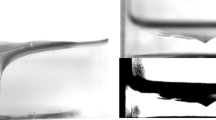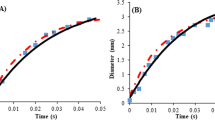Abstract
Non-intrusive two-phase fluid pumping based on an electrohydrodynamically (EHD) induced flow phenomenon with free liquid surface exposed to gas-phase corona discharges is experimentally investigated. Dielectric liquid flow generated near a corona discharge electrode progresses toward an inclined plate electrode, and then climbs up the surface against the gravitational force for an air-wave (AW) type EHD pump. The AW type EHD pump is operated on ionic wind field along the inclined plate electrode. The pumping performance of time-averaged liquid flow rate and the liquid-phase flow motion are characterized. The liquid flow characteristics related to a dimensionless parameter of corona discharge fields are presented.
Similar content being viewed by others
References
Stuetzer, O. M., Ion Drag Pressure Generation, J. Appl. Phys., 30-7 (1959), 984–994.
Yabe, A. and Maki, H., Augmentation of Convection and Boiling Heat Transfer by Applying an Electro-Hydrodynamical Liquid Jet, Int. J. Heat Mass Transfer, 31-2 (1988), 407–417.
Ohkubo, T., Hamasaki, S., Nomoto, Y., Chang, J. S. and Adachi T., The Effect of Corona Wire Heating on the Downstream Ozone Concentration Profiles in an Air-cleaning Wire-duct Electrostatic Precipitator, IEEE Trans. on Industry Application, 26 (1990), 542–549.
Chang, J. S., Stratified Gas-Liquid Two-Phase Electrohydrodynamics in Horizontal Pipe Flow, IEEE Trans. on Industry Application, 25-2 (1989), 241–247.
Bryan, J. E. and Yagoobi, J. S., Experimental Study of Ion-Drag Pumping Using Various Working Fluids, IEEE Trans. on Electrical Insulation, 26-4 (1991), 647–655.
Pickard, W. F., Ion Drag Pumping. II. Experiment, J. Appl. Phys., 34-2 (1963), 251–258.
Sharbaugh, A. H. and Walker, Q. W., The Design and Evaluation of an Ion-Drag Dielectric Pump to Enhance Cooling in a Small Oil-Filled Transformer, IEEE Trans. on Industry Application, 21-4 (1985), 950–955.
Melcher, J. R. and Taylor G. I., Electrohydrodynamics: A Review of The Role of Interfacial Shear Stresses, Ann. Rev. Fluid Mech., 1 (1969), 111–146.
Crowley, J. M., Wright, G. S. and Chato, J. C., Selecting a Working Fluid to Increase the Efficiency and Flow Rate of an EHD Pump, IEEE Trans. on Industry Application, 26-1 (1990), 42–49.
Davidson, J. H. and Shaughnessy, E. J., Turbulence generation by electric body forces, Experiments in Fluids, 4 (1986), 17–26.
Kaga, A., Inoue, Y. and Yamaguchi, K., Pattern Tracking Algorithm Using Successive Abandonment, J. Flow Visualization and Image Processing, 1–4 (1993), 283–296.
Chang, J. S. and Watson, A., Electromagnetic Hydrodynamics, IEEE Trans. on Dielectrics and Electrical Insulation, 1–5 (1994), 871–895.
Atten, P., Electrohydrodynamic Instability and Motion Induced by Injected Space Charge in Insulating Liquids, IEEE Trans. on Dielectrics and Electrical Insulation, 3-1 (1996), 1–17.
Chang, J. S., Two-phase flow in electrohydrodynamics, Part V, in: A. Castellanos (Ed.), Electrohydrodynamics, (Chapter 19 to 23), (1998), Springer, New York.
Hu, H., Saga, T., Kobayashi, T., Okamoto, K. and Taniguchi, N., Evaluation of the Cross Correlation Method by Using PIV Standard Images, J. Visualization, 1-1 (1998), 87–94.
Wawzyniak, M. and Yagoobi, J. S., An Analytical Study of Electrohydrodynamic Induction Pumping of a Stratified Liquid/Vapor Medium, IEEE Trans. on Industry Application, 35-1 (1999), 231–239.
Fayolle, J., Fournel, T. and Gervais, P., Comparison of PIV Parameters Effects on Displacement Identification and Cross Correlation, J. Visualization, 3-3 (2000), 253–256.
Ohyama, R., Watson, A. and Chang, J. S., Electrical Current Conduction and Electrohydrodynamically Induced Fluid Flow in an AW Type EHD Pump, J. Electrostatics, 53 (2001), 147–158.
Ohyama, R., Kaneko, K. and Chang, J. S., Flow visualization and Image analysis of Gas-Phase AC Corona Discharge Induced Electrohydrodynamic Liquid Flow in a Stratified Fluid, IEEE Trans. on Dielectrics and Electrical Insulation, 10-1 (2003), 57–64.
Pérez, A. T., Rose-Window Instability in Low Conducting Liquids, J. Electrostatics, 40&41 (1997), 141–146.
Chang, J. S. and Touchard, G., Electrohydrodynamics, IEEE Trans. on Dielectrics and Electrical Insulation, 10-1 (2003), 2–6.
Mizeraczyk, J., Dekowski, J., Podliński, J., Kocik, M., Ohkubo, T. and Kanazawa, S., Laser Flow Visualization and Velocity Fields by Particle Image Velocimetry in an Electrostatic Precipitator Model, J. Visualization, 6-2 (2003), 125–134.
Author information
Authors and Affiliations
Additional information
Ryu-ichiro Ohyama: He received his M.Sc. (Eng) in Electrical Engineering in 1988 from Tokai University. He also received his Ph.D. (Eng.) in Electrical Engineering in 1991 from Tokai University. He worked in Department of Engineering Physics, McMaster University as a visiting associate professor in 1999. He works in Electrical Engineering, Tokai University as an associate professor since 1996. His research interests are Quantitative Visualization in Electrohydrodynamically Induced Fluid Flow Field.
Masaki Kumeta: He received his B.Sc. (Eng.) in Electrical Engineering in 2001 from Tokai University. He also received his M.Sc. (Eng.) in Electrical Engineering in 2003. He works in Department of Electrical Engineering, Tokai University as a part-time researcher since 2004. His research interests are Quantitative Visualization in Electrohydrodynamically Induced Fluid Flow Field.
Akihiro Ueda: He received his B.Sc. (Eng.) in Electrical Engineering in 1999 from Tokai University. He also received his M.Sc. (Eng.) in Electrical Engineering in 2001. He works in Fujitsu Co. His research interests are Quantitative Visualization in Electrohydrodynamically Induced Fluid Flow Field.
Alan Watson: He received his B.Sc. (Physics) from Manchester University in 1954, the Diploma in Electronics from Southampton University in 1956, and the M.Sc. Tech degree in Electrical Engineering from Manchester University in 1963. After working with Metropolitan Vickers Electrical Corp on vacuum arcs and magnetohydrodynamics from 1958 to 1963 he then joined Curtis-Wright Corp in the U.S.A. briefly and then Ion Physics Corp in Massachusetts. He was awarded the Dr.rer.nat. degree in Physics from the Gesamthochschule, Kassel, Germany for his work on high voltage breakdown in vacuum. From 1970 to 1997 Dr. Watson occupied faculty positions at the University of Western Ontario and the University of Windsor, Canada retiring as professor in 1997.
Jen-Shih Chang: He received his M.Sc. (Eng.) in Electrical Engineering from Musashi Institute of Technology. He also received his Ph.D (Eng.) from the Center for Research in Experimental Space Science (CRESS), York University, Canada. During 1973–74 he was a Researcher at the Centre de Recherchers en Physique de l′Environment, CNRS, France. From 1975 to 1977 he was a Project Scientist/Assistant Professor at Department of Physics and CRESS, York University. He works in Department of Engineering Physics, McMaster University as a professor since 1979. His main research areas are applied electrostatics, electrohydrodynamics, pollution control and waste treatments.
Rights and permissions
About this article
Cite this article
Ohyama, R., Kumeta, M., Ueda, A. et al. A fundamental characteristic and image analysis of liquid flow in an AW type EHD pump. J Vis 8, 339–346 (2005). https://doi.org/10.1007/BF03181553
Received:
Revised:
Issue Date:
DOI: https://doi.org/10.1007/BF03181553




